
PUMPA - SMART LEARNING
எங்கள் ஆசிரியர்களுடன் 1-ஆன்-1 ஆலோசனை நேரத்தைப் பெறுங்கள். டாப்பர் ஆவதற்கு நாங்கள் பயிற்சி அளிப்போம்
Book Free Demo
Classification of animals based on vertebra
Is it possible to notice that different animals have the same type of neural system?
No, neurological systems differ in structure and complexity across the animal kingdom.
Invertebrates are animals that do not have a backbone (spinal column). Invertebrates include animals with no spines, such as insects, worms, jellyfish, and spiders, to name a few examples.
Important!
Invertebrates have aided in the understanding of how the nervous system functions. Scientists have used squid, leech, horseshoe crab, lobster, and cockroach as models to study the neurological system. In \(1963\), the squid even contributed to the Nobel Prize in Physiology or Medicine.
Invertebrates are helpful creatures to study because their neural systems are similar to those of vertebrates. Neurons in all animals use an electrochemical process to function. The function of invertebrates' more simple nervous systems is easier to learn.
We should understand certain terminology and their meanings before learning about the neurological systems of various invertebrates.
Nomenclature
- Ganglion - A ganglion is a collection or group of nerve cell bodies.
- Neurons – Specialised cells that transport chemical and electrical information from one location to another
- Sensory neurons - Sensory neurons synapse with interneurons to transmit information about the external and internal environments from sensory receptors to the CNS.
- Motor neurons - Motor neurons transmit impulses from the central nervous system to effector cells.
- Interneurons - Interneurons, which are found within the CNS and only connect with other neurons, integrate sensory and motor input.
- Synapses - A nervous system can be regarded as a well-organised collection of neurons that communicate through synapses or contact points. Synapses are points where the membranes of two or more neurons come very close together and are connected by specialised membrane characteristics.
- Sensory input - Sensory input is the transmission of messages from sensory receptors to the nervous system’s integration centres.
- Motor output - The transmission of signals from the processing centre to effector cells like muscle and gland cells that carry out the body’s response to stimuli is known as motor output.
Directional terms
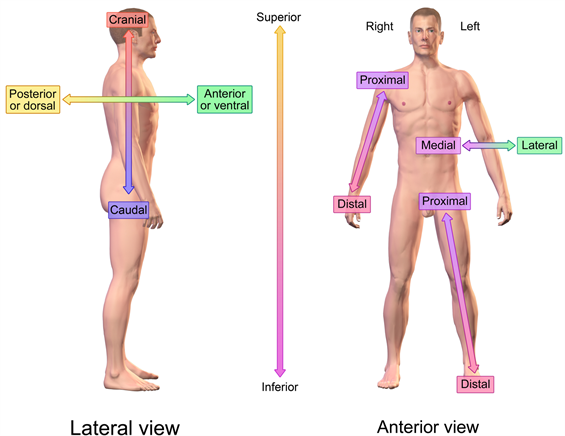
Anatomy directional terms of human
- Anterior - The front or direction toward the front of the body is referred to as anterior or ventral.
- Posterior - The back or direction toward the back of the body is referred to as posterior or dorsal.
- Superior - A place that is higher or higher than another section of the body.
- Inferior - A place below or lower (towards or toward the tail) than another region of the body is referred to as inferior or caudal.
- Lateral - The side or direction toward the side of the body is referred to as lateral.
- Medial - The centre or direction toward the middle of the body is referred to as medial.
- Proximal - Proximal refers to a place in a limb closer to the place of attachment or the body's trunk.
- Distal - Distal refers to a place in a limb farther from the place of attachment or the body's trunk.
- Superficial - The term "superficial" refers to a position that is closer to the body's surface.
- Deep - Deep refers to a place that is far away from the body's surface.
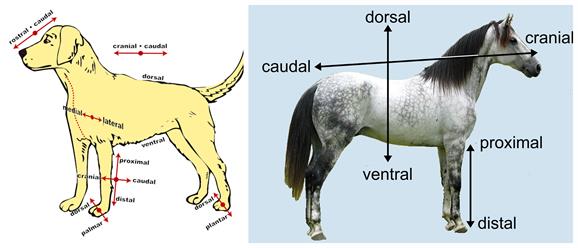
Anatomy directional terms of animals
Let us now look at the neurological systems of several species using examples.
Phylum: Porifera: E.g., Sponges
In comparison to other species, Porifera members lack a separate neurological system. They are devoid of brain and nerve cells. For oxygen intake, waste disposal, and digestion, they rely on water intake and output.
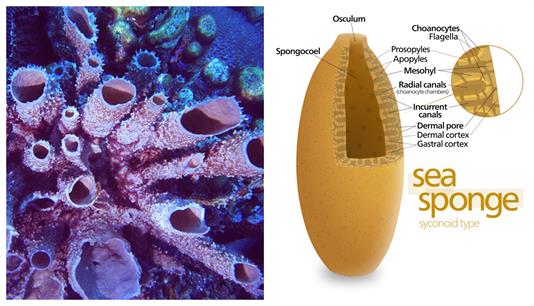
Structure and anatomy of sponges
The only multicellular animal without a nervous system is sponges. They lack nerve and sensory cells. However, outside of a sponge, touch or pressure causes a local contraction of the sponge's body.
Phylum: Coelenterata or Cnidaria: E.g., Hydra
Cnidarians have a nerve net, a diffuse, non-centralised nervous system; this is the first species in which the neurological system predominantly controls muscular contraction. Cnidarians are hence known as ‘net nerve animals.
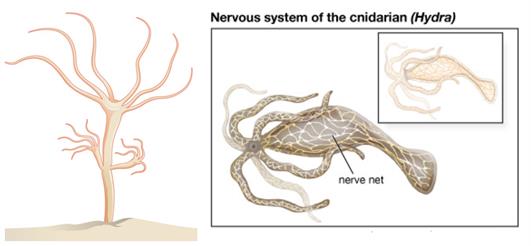
A nerve net characterizes the neurological system of the hydra. A nerve net is a cluster of neurons that are distinct but “connected.” Synapse connects neuron to neuron. At the synapse within a neural net, communication between neurons can happen in both directions. The nerve network is concentrated around the mouth. Unlike higher animals, the hydra does not contain nerve cell bodies that are clustered together. There are no ganglia in this area. Specific cells in the hydra handle touch and chemical detection.
Phylum: Ctenophora: E.g., Comb Jellies
A disorganised network of neurons exists in Ctenophora, which is similar to Cnidaria. Each comb plate contains the core network of interconnecting nerve cells. When a nerve pulse is activated in one of them, it is communicated to all cells that communicate with it via synapses. From there to others, it results in imprecise reactions, such as "pulsating" movements in living water when swimming. The most primitive type of nervous system is known as the diffuse nervous system.
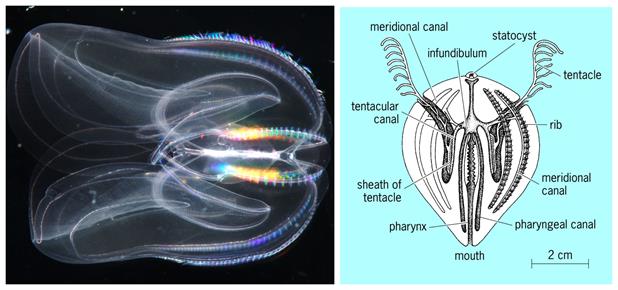
Structure and anatomy of Comb Jellies
Jellies don't have brains; instead, they have a nervous system made up of a network of connecting nerve cells (a nerve net). The entire body of jellyfish is enclosed in a nerve net. In addition, certain jellyfish feature rhopalia, which are specialised structures. There are receptors for in these rhopalia.
- Ocelli (light receptors) - Can detect the presence and absence of light.
- Statocysts (balance sensors) - It helps the jellyfish to determine whether they are facing up or down.
The statocyst makes touch with the cilium when the animal moves and its body is tilted. A nerve's action potentials are activated when the cilium bends. This gives you the information to move their muscles.
Phylum: Platyhelminthes: E.g., Flat worm
Platyhelminthes have a ladder-like nervous system. It consists of the brain and two main longitudinal nerve cords connected by transverse commissures at regular intervals.
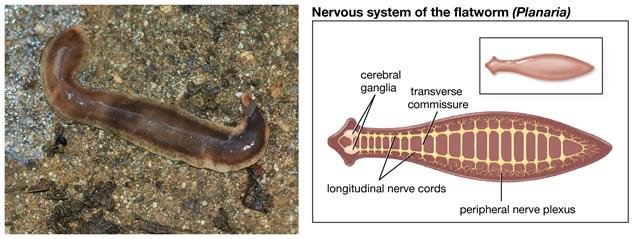
The neural system of the flatworm differs from that of the invertebrates described previously. It does have a nerve net; however, it is connected by long nerve cords. These cords are linked to the cerebral ganglia, which are found in the brain. Because of the nerves that connect the nerve cords, the central nervous system has been described as ladder-like.
Phylum: Aschelminthes: E.g., Round worm
Aschelminthes nervous system comprises a circumpharyngeal ring that gives rise to nerves, forwards, and backwards.

Structure and anatomy of round worm
Roundworms have a primitive brain and a simple nervous system. Four nerves connect the top to the bottom of the body and run the length of it. The nerves spread out from a circular ring that serves as the brain at the animal's front end (the head area).
Reference:
https://www.flickr.com/photos/icelight/208857632
https://commons.wikimedia.org/wiki/File:Sea_sponge_diagram.svg
https://commons.wikimedia.org/wiki/File:Blausen_0019_AnatomicalDirectionalReferences.png
https://commons.wikimedia.org/wiki/File:662px-Anatomical-directions.png
https://commons.wikimedia.org/wiki/File:Horse_Axes.JPG
https://commons.wikimedia.org/wiki/File:Figure_43_01_02.jpg
https://www.britannica.com/science/nervous-system
https://commons.wikimedia.org/wiki/File:Comb_jelly_2.jpg
https://commons.wikimedia.org/wiki/File:New_Zealand_flatworm_4.jpg
https://www.britannica.com/science/nervous-system/Diffuse-nervous-systems
https://commons.wikimedia.org/wiki/File:Canine_roundworm_2_with_scalebar.jpg